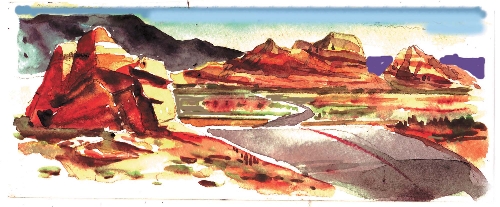Take along your camera when visiting Valley of Fire

Vividly colored sandstone formations occur in many places in the Mojave Desert, but the region preserved within Valley of Fire State Park stands out for scenic splendor. The eroded layers of stone deposited as sand dunes eons ago seem particularly colorful in the Valley of Fire, where iron oxide stains the stone in shades ranging from ash white to flaming orange and the deep red of embers.
Valley of Fire is just 55 miles from Las Vegas, easily accessed in an hour’s drive. Head north on Interstate 15, then east at exit 75. A Paiute tribal development near the exit markets fuel, food, water and supplies not available in the park. The park entrance is 18 miles from the freeway. As you approach the park, the paved road begins to wind before it drops precipitously into the showy sandstone cliffs, canyons and red dunes. Slow down and enjoy the scenery.
Expect to pay an entrance fee of $8 for Nevada residents or $10 for out-of-state visitors.
If you often visit Valley of Fire, a $75 annual pass at this park might save you money. Frequent visitors to this and other Nevada state parks should also consider the $100 annual parks passport.
Senior citizens 65 years or older who have continuously resided in Nevada for five years may purchase an annual senior pass for $30 that entitles them to free entrance and camping fees at all state parks. Other fees still apply, such as use of hookups at some campsites, boating fees and other special-use fees. Apply for the senior pass by mail after downloading a form from the Nevada Division of State Parks’ website. For details, visit the Southern Regional office in Las Vegas at 4747 Vegas Drive, open weekdays from 8 a.m. to 5 p.m., or call 486-5126.
Valley of Fire State Park remains open year-round, but at the height of summer, the heat is so stultifying, you won’t want to get out of your air-conditioned vehicle. Plan instead to visit the park during the cooler seasons when pleasant temperatures prevail, perfect for hiking, biking, picnicking, camping and photography. Camera buffs know that the calendar scenes throughout the park are best captured early or late in the day, when shadows provide contrast.
Stop by the visitor center in the heart of the park to learn more about this unique spot. It has a fascinating geological past and a long human history. The landscape changed drastically over time, leaving petrified logs from an age when forests covered the area.
Early native people exploiting the water available in the neighboring river valley left signs of their cultures dating back at least to 300 B.C. The native farmers and pueblo builders disappeared around 1150 A.D. Hikers often spot petroglyphs, rock writing left behind by earlier people. Find out more about them at the Lost City Museum in nearby Overton, located north of the park on Highway 169.
Several short designated trails to points of interest invite exploration on foot in such areas as the Beehives, Mouse’s Tank and the White Domes. Inquire at the visitor center about suggested longer routes. Hikers should wear closed footwear, layer clothing, use sunblock and carry water.
Bicyclists must stay on existing roads. There are 20 miles of paved roads within the park open to them. Off-road vehicle use is prohibited within Valley of Fire. However, a fine off-road trail system lies just north of the park in a similar landscape. Reach the Logandale Trails area by exiting the park to the east and following Highway 169 through Overton to Logandale. Turn on Liston Road and follow the signs.
Enjoy picnicking at several sites throughout the park or camping at Atlatl Rock or nearby Arch Rock, with a combined 73 sites, some with hookups. Nevada campers pay $8 per night, and others pay $10. Water and power hookups cost $10.
Campers experience night skies never seen in cities. The park is far enough from the light-filled Las Vegas Valley that many more stars are visible.
While you contemplate the starry night spectacle, you might hear subtle rustlings or a strange quavering chorus. Many of the native creatures in the Valley of Fire are nocturnal, including the coyotes. By morning’s light, the sandy areas of the park record the night’s wildlife traffic before the breezes obliterate the tracks.
Margo Bartlett Pesek’s column appears on Sundays.